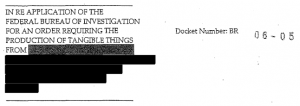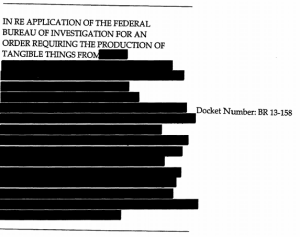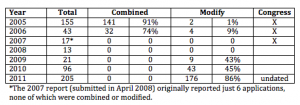NSA’s Bid for a 6 Month Delay in Protecting Larry Klayman’s Phone Records
The White House has announced they’re going to release the recommendations of the Committee to Make You Love the Dragnet today. Given that the report recommends putting the dragnet into someone else’s hands, I suspect the White House changed plans (It was going to release the report in mid-January) as a way to stave off the Klayman and other suits.
Given that we expect that recommendation — and that the government claims it’d take years to effect — I want to point to a claim that NSA Director of Signals Intelligence Division Theresa Shea made in her declaration in the Klayman suit. She claimed it would be an onerous process to take Larry Klayman’s call records out of the dragnet.
Beyond harming national security and the Government’s counterterrorism capabilities, plaintiffs’ proposed preliminary injunction would seriously burden the Government. While plaintiffs seek an order barring the Government from collecting metadata reflecting their calls, the Government does not know plaintiffs’ phone numbers, and would need plaintiffs to identify all numbers they use to even attempt to implement such an injunction. Ironically, as explained above, these numbers are not currently visible to NSA intelligence analysts unless they are within a three hopes of a call chain of a number that based on RAS is associated with a foreign terrorist organization.
Even if plaintiffs’ phone numbers were available, extraordinarily burdensome technical and logistical hurdles to compliance with a preliminary injunction order would remain. Technical experts would have to develop a solution such as removing the numbers from the system upon receipt of each batch of metadata or developing a capability whereby plaintiffs’ numbers would be received by NSA but would not be visible in response to an authorized query. To identify, design, build, and test the best implementation solution would potentially require the creation of new full-time positions and could take six months or more to implement. Once implemented, any potential solution could undermine the results of any authorized query of a phone number that based on RAS is associated with one of the identified foreign terrorist organizations by eliminating, or cutting off potential call chains. If this Court were to grant a preliminary injunction and the defendants were to later prevail on the merits of this litigation, it could prove extremely difficult to develop a solution to reinsert any quarantined records and would likely take considerable resources and several months to build, test, and implement a reinsertion capability suited to this task.
Judge Richard Leon treated this complaint as the obvious bullpuckey it clearly is.
[T]he Government says that it will be burdensome to comply with any order that requires the NSA to remove plaintiffs from its database. Of course, the public has no interest in saving the Government from the budens of complying with the Constitution! Then, the Government frets such an order “could ultimately have a degrading effect on the utility of the program if an injunction in this case precipitated successful requests for such relief by other litigants.” For reasons already explained, I am not convinced at this point in the litigation that the NSA’s database has ever truly served the purpose of rapidly identifying terrorists in time-sensitive investigations, and so I am certainly not convinced that the removal of two individuals from the database will “degrade” the program in any meaningful sense.68
[snip]
In [staying my order to destroy the plaintiffs’ metadata] I hereby give the Government fair notice that should my ruling be upheld, this order will go into effect forthwith. Accordingly, I fully expect that during the appellate process, which will consume at least the next six months, the Government will take whatever steps necessary to prepare itself to comply with this order when, and if, it is upheld. Suffice it to say, requesting further time to comply with this order months from now will not be well received and could result in collateral sanctions.
68 To the extent that removing plaintiffs from the database would create the risk of “eliminating, or cutting off potential call chains,” the Government concedes that the odds of this happening are miniscule. (“[O]nly a tiny fraction of the collected metadata is ever reviewed . . . .”) (“Only the tiny fraction of the telephony metadata records that are responsive to queries authorized under the RAS standard are extracted, reviewed, or disseminated. . . . “). [citations removed]
But the plea for time– when it’s crystal clear NSA could start treating Larry Klayman’s data like a high volume number they intentionally defeat on intake tomorrow — made me wonder what purpose this complaint was really meant to serve, especially given James Cole’s refusal the other day to answer whether the Leahy-Sensenbrenner bill would eliminate bulk collection, which Jennifer Granick likens to a coup.
Responding to a question at yesterday’s hearing on the bill, Cole said, “Right now the interpretation of the word ‘relevant’ is a broad interpretation. Adding ‘pertinent to a foreign agent’ or ‘somebody in contact with a foreign agent’ could be another way of talking about relevance as it is right now. We’d have to see how broadly the court interprets that or how narrowly.” In other words, the FISA court might let us keep doing what we’re doing no matter what the law says and despite Congress’ intent.
All courts issue opinions about what the laws that legislatures pass mean. These opinions are called the “common law”. But common law interpretations of statutes are only legitimate if they are fair and reasonable interpretations.
The NSA has a great track record getting FISC judges to interpret even obviously narrow phrases in surprisingly broad ways.
[snip]
Time and again, the FISC accepts the Administration’s shockingly flimsy arguments. As a set, the few public FISC opinions we’ve seen suggest that the Executive Branch—in cahoots with a few selected judges—has replaced legitimate public statutes with secret, illegitimate common law.
The rule of law is a basic democratic principle meaning that all members of a society—individuals, organizations, and government officials—must obey publicly disclosed legal codes and processes. If Cole is right that, try as it might, Congress cannot end bulk collection because the secret FISA court may defer to the NSA’s interpretation of the rules, there is no rule of law. The NSA is in charge, the FISA court process is just a fig leaf, and this is no longer a democracy. There’s been a coup d’etat.
But it appears that not even the FISC judges are always in on the game. After all, at the moment when Judges Walton and Bates started reining in the Internet dragnet in the US, NSA started rolling out an expanded Internet dragnet program — which made it easier to pick up US person data and presumably easier to disseminate it — overseas. With that 6 month delay, would NSA just be figuring out how to maintain the dragnet function, but beyond the reach of meddling judges like Richard Leon?
The NSA suggested it would need 6 months notice to take just two people out of the dragnet. I can imagine no feasible technical reason that’s true.
So why were they implying they’d need that 6 months?



